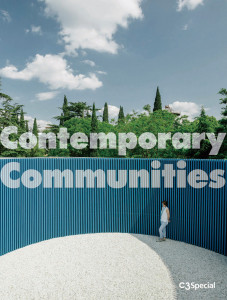press

Media library [Third-Place] in Thionville
Contemporary Communities
16 Projects
224p / pur & jacket / USD 38
한국내: 42,000원
ISSN : 2092-5190
size : 23 x 30 cm
language : English / Korean
CONTEMPORARY COMMUNITIES
and the complex array of forces affecting them CONTEMPORARY_Anna Roos
On the Roofs of Community_Sabrina Puddu
Nam Dam Homestay and Community House_1+1>2 Architects
Bamboo Sports Hall for Panyaden International School_Chiangmai Life Architects
Community Center in El Rodeo de Mora_Fournier - Rojas Arquitectos
The South Yard_Advanced Architecture Lab + Atelier UPA
Library and Sheltered Workshop_CeZ Calderan Zanovello Architetti
House of Music in Pieve di Cento_Mario Cucinella Architects
Prader Grocery Store_Messner Architects
The New Scout Hut and Village Hall_Sophus Søbye Architects + WE Architecture
Substrate Factory Ayase_Aki Hamada Architects
Blue Barn Theater & Boxcar 10_Min|Day
Impluvium Community Center in Reinosa_RAW / deAbajoGarcia
Media Library in Thionville_Dominique Coulon & Associés
Marinilla Educational Park_El Equipo Mazzanti
Dongyuan Qianxun Community Center_Scenic Architecture office
Enabling Village_WOHA
Media Library in Tbilisi_Laboratory of Architecture #3
오늘날의 공동체를 만드는 힘 오늘날의 공동체를 만드는 힘_안나 로스 공동체의 지붕 위_싸브리나 푸뚜 남담 마을 커뮤니티 단지_1+1>2 아키텍츠 판야덴 국제학교의 대나무 체육관_치앙마이 라이프 아키텍츠 엘 로데오 데 모라 커뮤니티 센터_푸르니에르-로하스 아르끼떽또스 산지아 마을회관_어드밴스 아키텍쳐 랩 + 아틀리에 UPA 파씨리아 산마르티노 도서관_쎄즈 칼데란 자노벨로 아르끼떼띠 삐에베 디 첸토 음악원_마리오 쿠치넬라 아키텍츠 빠라데르 식료품점_메쓰너 아키텍츠 쇤데르마르켄 마을회관_소퍼스 소비 아키텍터 + 위 아키텍쳐 아야세 마을회관_아키 하마다 아키텍츠 블루반 복합문화극장_민 데이 레이노사 커뮤니티 센터, ‘임플루비움’_로우/데아바호가르시아 티옹빌 미디어 도서관_도미니크 꼴룬 앤 어쑤씨에 마리닐라 교육문화원_마짠티 건축사무소 샹청 커뮤니티 센터_씨닉 아키텍쳐 오피스 장애인 자활지원센터, 인에이블링 빌리지_WOHA 트빌리시 시립 미디어 도서관_넘버쓰리 건축연구소
Contemporary Communities
At a time of unprecedented urban migration with an estimated 1.5 million people per week (!) moving to urban centers, it is imperative to analyze what makes communities thrive. The people who decide how and where new cities are built and how they function impact millions if not billions of peoples’ lives in fundamental ways. Urban planners sometimes seem to forget that cities are not just stagnant physical objects, but are rather complex, evolving, living systems. It must be remembered that a city equals a community of people not a bunch of buildings. This should not be forgotten in the rush to get buildings built to earn a quick buck. There is no point in planners behaving like demi-gods, looking down from an elevated vantage point with grand idealistic projects that end up being uninviting and soulless. We need to remember the dire failures of the so-called urban renewal projects that took place in cities all over America, starting in New York and spreading like a cancer to Detroit, Denver and dozens of other cities in the 1950s and 1960s only to be torn down a decade later. They were literally so unloved, indeed detested by those who lived there, that they crumbled. Shiny utopian dreams turned to depressing dystopian nightmares—a tragic and shameful waste of peoples’ lives and public resources. We need to look carefully at why these projects were so disastrous for the people who lived there. In order to avoid creating inhospitable ghettoes, we need to think about the relationship of city to building, building to sidewalk, sidewalk to street, and street to public realm. ... ... written by Anna Roos
On the roof of communities
Sociologist Richard Sennett argues that the main tension in modern cities lays in the simultaneous desire for individual freedom and communal bonds, the predecessor of such a phenomenon to be found in the dichotomy economy/religion as propagated in medieval cities. It is exactly in the gap left by the fall of the Roman Empire that an idea of community was shaped as a place of exemplary and sometimes contrasting moral reference for the whole society; it was firstly incubated in the countryside – in the walled Christian monasteries and abbeys dotting the rural realm – to then flourish in the heart of the reborn European city. ... ... The formation of the national states in the XIX century was coupled with the birth of new laic institutions, whose absolute end was to shape the modern subject on the basis of enlightened bourgeois values. The Museum, the Theatre, the Hospital, the Library, and the Prison became the elements of a taxonomy made popular by Jean-Nicolas-Louis Durand. ... ... written by Sabrina Puddu